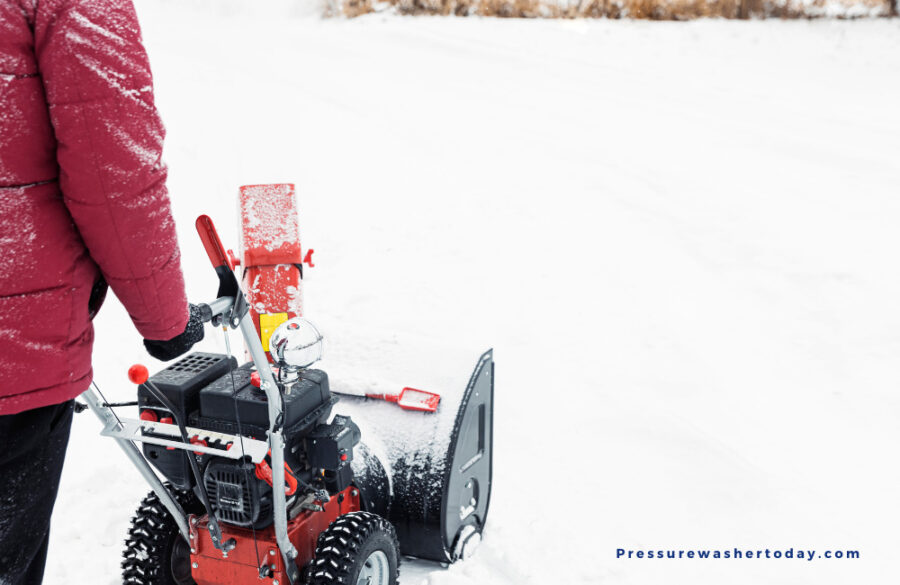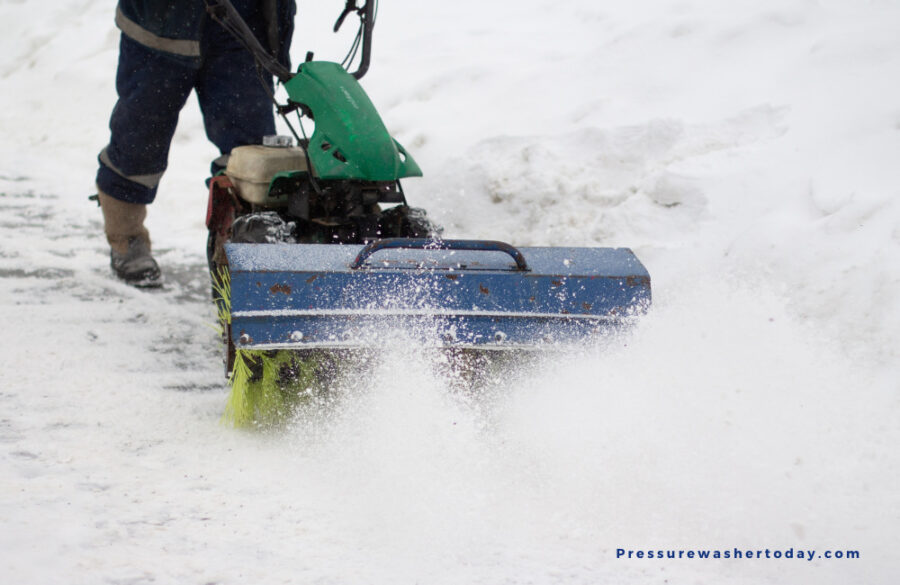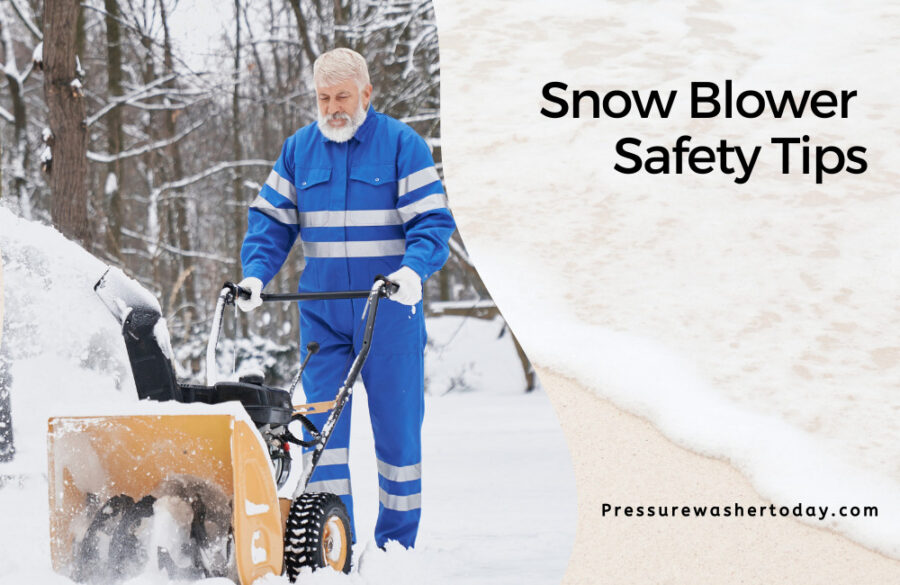So, winter, what does it remind you of? The white snow, the streets covered with a white layer, houses painted with beautiful white snow, kids making a snowman, and adults cleaning out the same snow with snow blowers. Snowblower safety season arrives with the snow.
Now, dusting off the snow with a snowblower looks like an easy-peasy task. In reality, dig a little further and you’ll find a whole heap of snowblower injury incidents. Mostly hands and fingers are victims of these gruesome accidents.
The prominent cause is when users try to clean the auger/collector and the discharge chute with their bare hands. They get caught in the machine; some survive while some unfortunate souls die.
The “Improper Rule” also applies here too. Mistreating or not handling the snowblower with caution also leads to injuries.
To avoid these horrible incidents, you should prepare yourself and equip yourself with essential knowledge. So, let’s begin…
Table of Contents
Snow Blower Safety Tips# 1st Winter – Prepare Yourself
The first and foremost thing is to prepare yourself mentally and physically.
1. Pace Yourself
Even though snowblowers make your job done conveniently in a good time, you should take breaks to revive yourself. Don’t push yourself beyond your limits.
2. Stay Focused
Pay heed and concentrate. Do not be distracted by any other kind of activity. Also, refrain from addictive liquors (beer), medications, and drugs before using the snowblower.
3. Read the Manual
All snow blowers are equipped with the instruction manual. The work of all snowblowers is the same but functioning and method of operation might differ depending on the type you have. So, read the “Manual” to avoid any mistakes in operating.
If you’re a 1st timer, then the “Manual” is like a lifeline for you. Many unfortunate snowblower accidents happen with 1st-time users because they didn’t read the manual.
4. Plan Your Route
Before you hit the button, you should plan your route. Planning also includes cleaning out the area of anything that can get stuck in the machine or can hinder your work, such as debris, stones, newspapers, doormats, etc. Also, beware of the sloped areas and holes in the ground.
Planning Your Route” is also the best way to avoid harm to yourself, other people, and pets. See also the “2nd Winter > People & Pets Protection” section.
5. Mark Your Days
Before you go into action mode you should mark your days. Blowing several times during snowfall and stormy days is a good idea. However, there are varying opinions on this.
Because during those times the snow is not wet and heavy. Thus, it doesn’t clog the snowblower.
Snow Blower Safety Tips# 2nd Winter – Protection Comes First

Now, mental training is over. Next up is the physical aspects you need to cover to avoid any sad mishaps. So, let’s move on to clothing.
1. Don’t Wear Loose Clothes
Avoid wearing loose clothing when you’re operating a snowblower because they’ll get caught in the moving parts of the machine and pull you along as well. This includes loose pants, jackets, sleeves, dangling scarves, etc.
2. Protect Your Ears
Wear an earmuff to protect yourself from the loud noise. Gas snow blowers are loud ones reaching beyond 80 DBS.
People who are sensitive to sounds or who are using a hearing aid should consult their respective doctors before these kinds of jobs.
3. Safeguard your Eyes
Along with ears guard your eyes because there will be a lot of dust or snow splashing around through the chute. So, using safety glasses will protect you from debris and dust particles. Here dust particles are been referred to are dirt, twigs, and small rocks beneath the snow layer.
4. Heart Problem
Working with a snowblower is quite an exciting and fun thing to do but not for people with heart problems. In winter months, the risk of heart attack is maximized because in the cold and our arteries tend to constrict more, thus raising blood pressure which could cause a heart attack.
The reason behind this is overexertion. We know snow blowers reduce exertion compared to snow shoveling. However, that does not give you a green light to overexert yourself.
So, if you’re a heart patient then you should consult your doctor before doing these kinds of winter chores. Another precaution is that folks with “Hypertension, High Blood Pressure, and Diabetes” should also consult with their respective doctors before doing any type of winter chore, let alone the snowblower job.
Tip: Take regular breaks in-between to avoid over-exertion.
5. Watch Your Step
Usually, the thick layer of snow covers the entire surface hiding the steep slopes on the ground. Clearing snow from steep slopes or in front of them causes the machine to tilt or topple over.
That is why it tends to cause a problem when removing snow from steep slopes as I have said before in the “1st Winter > Plan Your Route” section.
6. People & Pets Protection
Never direct the face of the chute on traffic or people. The chute expels the snow under pressure and it could cause harm.
Watch out for the pets and animals in the surrounding area.
Snow Blower Safety Tips# 3rd Winter – The Culprit Machine

Let’s discuss further the precautionary measures and handling tips for snowblowers.
Uncaring operation or ignoring the guidelines will lead to serious damage both to the machine and the operator.
1. The Fumes Are the Poison
The downside of the gas-powered snow blower is the exhaust of carbon monoxide fumes. Carbon monoxide (CO) is a toxic gas and may become hazardous if it is trapped anywhere inside when you start the engine indoors.
Thus, it is recommended not to operate the gas blower inside a garage, cabin, or shed. You should power up the gasoline in the open air or a well-ventilated area to avoid becoming the victim of CO.
2. Don’t Attempt to Repair the Machine
Snowblowers may also develop faults and need repair. However, the repair is not always DIY, as it depends on the nature of the problem.
If you want to repair your blower on your own, it is suggested to you study the owner’s manual. Usually, it is best to seek the help of a skilled mechanic.
3. Use an External Extension Cord
If you have an electric blower, plug it into an extension cord that is rated for your model. Ensure that the cord is connected to the outlet with earth connection for additional safety.
While working, be cautious about the cord not to be in the way of the spinning auger. Track the blower away from the cord with utmost care.
4. The Cord is the Dark Horse
The cord of the electric blower is a potential safety threat. To avoid any mishap, verify that the cord is not damaged, frayed, or burned. Otherwise, you are at risk of electrocution or electric shock.
Also, double-check the cord is not severed by being trapped in the machine.
5. Don’t Force the Pull Cord
Sometimes the cord is stuck under the blower and doesn’t move freely. Don’t pull the cord forcefully as it could cause a back injury.
6. Don’t Leave the Snowblower Running Unattended
Avoid leaving the blower on when unattended as this will lead to the accumulation of carbon monoxide fumes and the risk of injury as well.
Moreover, the running blower has sharp blades rotating speedily which might cause serious injury if any unwary person goes near it.
7. Clogged Snowblowers
Snowblowers conveniently help you to de-ice pathways. However, a clogged blower resists the job and makes it tough. It becomes harder to cope with the field of wet, heavy, and packed snow.
Don’t get disappointed or frustrated. After making a few adjustments, you can unclog your chute and are back on the way to shave the snowy route.
Also, be cautious while dealing with clogged snowblowers. Hand or finger injuries including amputation do occur.
The tragic story begins when the snow is accumulated and clogs the exit chute of the blower. The blades are still rotating for a short time even when the machine is powered off.
In most cases, during that time, the operator hurriedly attempts to unclog it with his hand. The cruel sharp blades cut whatever comes in their path, showing no mercy.
Steps to Keep Snowblower from Clogging
- Keep up a brisk pace. The snow is less likely to stick on the fast-moving blades.
- Perform the repeated sequences of blowing processes.
- It is suggested to spray the blades and chute with non-stick spray to shield the auger from snow sticking, clumping, or clogging. Cooking oil also does the job but it gets messy and does not last for long.
Steps to Unclog the Snowblower
- Switch Off the engine or unplug the cord of the electric snowblower
- Wait for the impeller blades to stop rotating
- Use a clearing tool, a long stick, or broom handle to dislodge the snow and debris
- Never insert your hand or feet around the blades or chute. A clogged auger and impeller have stored energy even in a stationary state due to belt tension that can hurt your hand or feet.
- Keep the shield in the right place.
- Just to refresh your memory again … keep your hands and feet away from all the movable parts.
Once the clog is swept away fully, you can plug in and power up your machine and resume snow blowing.
Remember
- Stay focused on the snow-blowing job
- Wear nonskid boots to stay safe from slipping
- Don’t consume alcohol or similar narcotics before operating the machine
- Keep children away from the machine and don’t allow them to operate it.
- When you want to maneuver the blower, it should be powered off with the spark plug disconnected and unplugged.
- It is not advised to lift the shovel from the base, even when it is stationary. The brutal sharp blades can cause severe injury.
Upon suffering from an injury, seek medical assistance immediately.
Snow Blower Safety Tips# 4th Winter – Finishing
We are concluding with a few important, although simple procedures, specified below. By following them you should enjoy the consistent and optimum performance of your snowblower for a long time.
1. Turn Off
As I said before in the 3rd Winter, do not leave the blower unattended. Remember also to shut off the engine completely, when you finish your snow job. Before leaving the machine, make sure that it is turned off fully.
2. Maintain
You should maintain your snowblower to closely shave off the pathways and get your job done in good time.
As directed by the manufacturer, clean and service the auger and related parts at stated times.
3. Fueling
Always top up the gas before powering up the snowblower. However, if you forget to replenish the tank and the fuel runs out during the middle of the job, do not be over-hasty to fill up the gas. Wait and let the engine cool down fully and then start refueling. Also, fuel the snowblower outside and away from the ignition sources.
For additional precautionary measures, store the gasoline container outdoors and keep it capped.
Report
If you don’t know how to fix an issue, when it occurs, you can simply report it to the technical support of the manufacturer. Don’t try to resolve the issue on your own as it may increase the repair cost and extend the downtime of the machine.
Author’s Bio: Hassan Kurd is a cool-headed, optimistic guy and the Founder of Tool Miner

